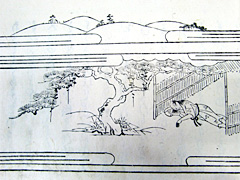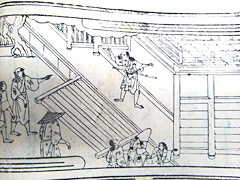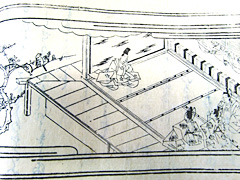Top>Opinion>Monokusa Taro's Konkatsu
 Index
Index

Tomomi Yoshino [Profile]
Monokusa Taro's Konkatsu
Tomomi Yoshino
Associate Professor, Faculty of Letters, Chuo University
Area of Specialization: Classic Japanese Literature
After all the konkatsu effort...
It has been a while since the term konkatsu-meaning spouse-hunting, a play on the term shukatsu, which refers to the fervent job-hunting process in Japan-entered the lexicon. The recent trend seems to show that an increasing number of people have been unsuccessful in their konkatsu, falling mentally and physically ill with irritable colitis, or having negative thoughts stemming from anxieties and the fear of rejection. One mental clinic has reportedly even set up a help desk for konkatsu fatigue (Yahoo! News, dated August 11), which shows that it no simple matter to succeed in konkatsu and cross the threshold to marriage.
The ultimate slacker
Here's a profile of a certain kind of guy: He's always lying around; he drops things but doesn't get up to retrieve them and instead asks people passing by to pick them up. When they don't, he curses them. Is this your Dad on the weekend? Or your lazy son? No, no, this is an episode from Monokusa Taro, an otogizoshi (a genre of medieval Japanese folktales) that developed in the late Muromachi Period, which talks about how lazy its protagonist is. Monokusa Taro is (among other things) a story of this slacker pulling off a successful konkatsu. So how did he end up getting married?
The plot of Monokusa Taro

Monokusa Taro Hijikasu, a resident of Atarashi-no-sato village in Chikuma county of Shinano province, was a slacker like none other in the nation. Living in a hut made of bamboo and straw, he lay amidst fleas, lice, and grime and sometimes wouldn't get up for four or five days. Once he accidentally dropped a mochi rice cake that someone had given him, and it rolled into the street. Too lazy to go pick it up, he waited for someone to pass by. On the third day, the lord of the manor passed by. Taro arrogantly asked him to pick up the rice cake, and when he refused, Taro complained. The landowner developed an interest in the slacker, and considering that fate must have given life to such a man on his own land, he ordered his vassals to feed Taro.

Late in the spring three years later, a Shinano official ordered the village to send a laborer to the capital, Kyoto. The troubled peasants tried convincing Taro to go for them. Upon hearing that if he went to the capital he could become a wealthy man and marry a beautiful wife, Taro accepted. Putting his usual laziness aside, he packed and went to the capital. In Kyoto, he worked diligently, to the point of working beyond the agreed period. On his way home, he remembered that he wanted to bring home a good wife, so he asked a lodge owner how to marry a woman. Taro was advised to undertake an act known as tsujitori-the practice of taking a wife by kidnapping a woman passing by on the road. So, standing at a crossroads on the grounds of Kiyomizu Temple, which was then bustling with festival activities, Taro fell in love with a young woman serving a member of the nobility. The woman trembled with fear when a grimy Taro suddenly hugged her on the street, but seeing Taro to be a country boy, she tried to put him off with riddles and witty remarks. To her surprise, Taro answered them all. She would throw him a poem, and he would return one with engo (word associations), kakekotoba (plays on words), and other appropriate elements. The woman, while impressed by the unexpectedness, taste, and talent of this young man composing stunning poems with such spontaneity, gave Taro a riddle in the form of a poem and ran away. Solving that riddle as well, Taro found the woman's home and added offerings of witty waka (poems) and renga (collaborative poems) as gifts, which also hinted at the tenderness of his feelings for her. Taro wins the woman over in the end, and she agrees to marry him.

Grimy Taro then takes a hot bath for seven consecutive days and is transformed into a stunningly handsome man. Learning manners from his wife and donning graceful clothing, his looks were then compared to a kugyo (a type of dignitary, such as ministers and upper house members) or a tenjobito (member of the emperor's staff), and he also earned a reputation as a master of waka and renga. Taro finally held an audience with the emperor, and when he answered the emperor's request to compose a poem, his highness was deeply touched. Suddenly finding a deep interest in Taro's origins, the emperor ordered Shinano province to investigate. They discovered that the son of Emperor Ninmyo, who had been sent into exile in Shinano, where he had become second chujo (lieutenant), had prayed at Zenkoji shrine and been blessed with a son, which was Taro. Subsequent to this discovery, Taro became chujo of Shinano, was given both the Kai and Shinano provinces, and moved into the area with his wife. At Shinano, Taro repaid the kindness of the landowner who had offered to take care of him and the peasants who had fed him for three years, and spent his life blessed with children. It is said that Taro was later enshrined as the Daimyojin of Otaga and his wife as the Gongen of Asahi-the gods of love.
The dream and idol of the people
"Monokusa Taro" is a story about a protagonist transforming himself and succeeding in life, as well as a romance in which a man demonstrates his hidden talent to win the woman of his dreams. Also taking the form of a classic nobleman-becomes-commoner story, and even containing the style of divine origins, this all-inclusive work was read favorably by the new commoner class it targeted.
The story, while set in the Heian Period, illustrates many scenes that represent the social affairs and customs of the Middle Ages. These include: People who lived like Taro and occupied much of the lower part of society; a rise-to-power social norm of a man who seizes an opportunity to achieve greatness; the culture of tsujitori where men would pick up (literally) a woman at street corners or a market and try to make her theirs; and the story's setting at the main gate of Kiyomizu Temple, renowned for its goddess of romance and marriage and for her miracles, which made it a popular meeting spot for couples.
Yet among all this is a dynastic aspect, for want of a better term, of a poetic talent-which most commoners would never require-which helped in Monokusa Taro's search for a spouse (as well as in his life, ultimately), which helped him achieve grand success, and which was quite exciting. Be sure to note that Taro's skills at waka and renga had the qualities necessary to make them gifts, improvising engo and kakekotoba to match the scene and form of witty exchanges. (Note) Because this tells us that the target readers of this story had dreams, and that, although waka is a sophisticated skill requiring real technique, this skill could make such great things happen if you could compose them.
The secrets to Taro's success
What made Taro's konkatsu a success was ultimately his hidden talent, which moved the heart of a woman who recognized it. While he was handsome and of noble birth, that was not a decisive factor since the woman didn't know about that at the time they got married. But what we need to bear in mind is that underneath Taro's ability to demonstrate his talent was tolerance of the people around him who fed him as a slacker, the fact that he worked earnestly to make something out of an opportunity that he may have been coaxed into, but which was offered nonetheless, and that he had the sincerity to face up to a woman with all honesty-almost unwittingly-and he had talent that he could put to use in clutch situations.
As I mentioned earlier, it seems that contemporary konkatsu is no simple undertaking. I can imagine that those involved really have it tough. But why not rest easy (and have your peers rest easy too), in the knowledge that even Monokusa Taro transformed over time and succeeded. Feel free to spend your life leisurely doing what you like and secretly brushing up on what you are good at, waiting for a partner to come at the right moment. (Recognizing this moment when it arrives is important.) It's a way of life you might want to consider.
(Note) When, for example, Taro broke his wife's koto (traditional string instrument), much to her dismay, he immediately said, "Kotowari nakereba monomo iwarezu." (Meaning, "You have every reason; I'm so sorry I'm at a loss for words," using kotowari as a play on words, meaning both "break the koto" and "reason"). That's the kind of skill we're talking about. Though this is more of a pun and we have to question its quality as a poem... But the quick response is what's important.
*The image is from "Monokusa Taro" in the book, "Otogizoshi Nijyusanshu (23 Short Stories)" (913.49/O86) as stored in the Japanese Literature Research Center at Chuo University.
- Tomomi Yoshino
Associate Professor, Faculty of Letters, Chuo University
Expertise: Japanese classic literature - [Profile]
Born in Tokyo in 1970, Professor Yoshino Graduated from the Faculty of Liberal Arts at the University of the Sacred Heart. She earned a PhD. in Literature from the Graduate School of Humanities and Sociology in the Faculty of Letters (Japanese Cultural Studies) at the University of Tokyo. Professor Yoshino was a member of the Research Fellowships for Young Scientists at the Japan Society for the Promotion of Science, and an Assistant at the Japanese Literature Research Center in the Faculty of Letters at the University of Tokyo before becoming a lecturer on the Faculty of Letters at Chuo University in 2007, then taking up her current post in 2009. Professor Yoshino specializes in classical Japanese literature (Medieval Literature), with a particular interest in the waka (a 31-syllable Japanese poem) of the late Heian Period and early Kamakura Period. She was the winner of the 31st Japan Classical Literature Foundation Award. Professor Yoshino co-authored Horikawa-in Hyakushu Waka (Meiji Shoin, 2002), Toshiyori Jukkai Hyakushu Zenshaku (Kazamashobo, 2003), Jien Naniwa Hyakushu Zenshaku (Kazamashobo, 2009), and the paper "Gotoba-in ni okeru Minamotono no Toshiyori" (Kokugo to Kokubungaku, September 2009), among other publications.
- Research Activities as a Member of Research Fellowship for Young Scientists (DC1), Japan Society for the Promotion of Science (JSPS) Shuma Tsurumi
- Important Factors for Innovation in Payment Services Nobuhiko Sugiura
- Beyond the Concepts of Fellow Citizens and Foreigners— To Achieve SDGs Goal 10 “Reduce Inequality Within and Among Countries” Rika Lee
- Diary of Struggles in Cambodia Fumie Fukuoka
- How Can We Measure Learning Ability?
—Analysis of a Competency Self-Assessment Questionnaire— Yu Saito / Yoko Neha - The Making of the Movie Kirakira Megane








